Thu 2 Dec 2021
Mike Nevins Reviews the Early PI Novels and Stories of HENRY KANE.
Posted by Steve under Authors , Columns , Reviews[8] Comments
by Francis M. Nevins
In 1946, soon after the end of World War II, the editors of the high-paying Esquire decided to launch a series of short detective stories and invited several authors to create a new character for possible publication in the magazine. Among those solicited was that incomparable filbert Harry Stephen Keeler (1890-1967), who strung together an outrageous plot about a barking clock and an astigmatic witness and dreamed up a 7½-foot-tall mathematically-educated hick from the sticks as his new detective.
Reasonably enough, Esquire rejected the story. Who won the prize that Keeler lost? A guy who happened to have the same first and last initials as our Harry. The subject of this column.
About the life of Henry Kane very little has surfaced. He was born in New York City on 18 May 1908 as Henry Cohen and apparently graduated from one of the city’s several law schools in the 1930s. How long he practiced law is unknown, but it does seem clear that he preferred writing to legal work.
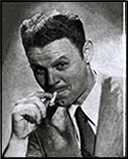
Whether he served in World War II is also unknown. At the time of Esquire’s hunt for a new series character he seems to have published nothing, and what the editors saw in him is likewise a mystery. The character he created for the magazine was Peter Chambers, a tough but sophisticated Manhattan private richard (as he prefers to call himself) whose first appearance in short-story form was “A Glass of Milk†(Esquire, February 1947).
It was also early in 1947 that Chambers debuted as protagonist of a hardcover novel. Whether the early short stories preceded or followed A HALO FOR NOBODY (Simon & Schuster, 1947) is anyone’s guess: my own is that at least the first couple of them came first. Kane stayed with S&S for a few years, then migrated to the field of paperback originals where he flourished during the Fifties and Sixties, having Chambers narrate his own cases in a wackadoodle style which his admirers have dubbed High Kanese.
It’s likely that Chambers was the uncredited inspiration for the hit TV series PETER GUNN (NBC, 1958-61), for which the tie-in novel (PETER GUNN, Dell pb #B155, 1960) was written by, you guessed it, Henry Kane. Later in the swinging Sixties Kane reconfigured his character as protagonist in a series of X-rated paperbacks for Lancer (1969-72).
During the final phase of his career he turned out a number of stand-alone hardcover thrillers, some under his own byline, others as by Anthony McCall, Kenneth R. McKay, Mario J. Sagola (a name probably meant to evoke the Godfather saga) and Katherine Stapleton. He died in his home at Lido Beach, Long Island on 10 October 1988.
A HALO FOR NOBODY opens with a report by Chambers to his friendly enemy NYPD Lieutenant Louis Parker, and of course to us: he was walking down Park Avenue in the lower Eighties on the way to an appointment with a potential client when, a block or so ahead of him, he witnessed an attempted kidnapping and the murder of a woman, who turns out to be the potential client’s wife.
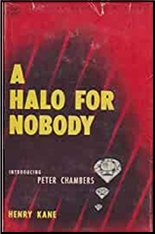
Being armed at the time — which establishes, I suppose, his machismo — he fired several shots into the back of the taxi in which the criminals were escaping. The taxi is later found in Central Park with two dead men in it: the driver and a known hoodlum.
Soon afterwards, Chambers is hired by the dead woman’s husband not to solve the murder of his wife, whom he hated, but to find out why someone is trying to blackmail him when he knows he’s done nothing blackmail-worthy. It would take several pages of summary to penetrate deeper into Kane’s Chandleresque plot labyrinth and I doubt it would benefit anyone to read them.
When A HALO FOR NOBODY was published in 1947, Kane was touted by Simon & Schuster as “a worthy successor to Dashiell Hammett.†Talk about ridiculous! The main connection between the two is that Kane, like so many others, borrowed from Hammett the climax of THE MALTESE FALCON.
To Raymond Chandler he owed a bit more, including some elements of his protagonist — even the names have the same cadence, Philip Marlowe and Peter Chambers — and the all-but-incomprehensible labyrinthine plot, although he does keep to a reasonable minimum the vivid figures of speech in which Chandler indulged perhaps too often.
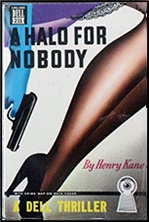
The stylistic feature of HALO that jumps out at the reader is Kane’s habit of converting several short sentences into a single long one by the repeated use of the most common conjunction in the language. Here’s an example from a nightclub scene.
I have a vague recollection that this trope started with Hemingway but I doubt that Papa used it to anywhere near the same extent as Kane.
Anyone writing a dissertation on political incorrectness in PI fiction will go no farther than Chapter Four when Chambers encounters a gay ex-gangster and calls him, to his face, “a fairy, a phony, a queerie, a pervert.†Any such reader will miss perhaps the most memorable scene in HALO, the gunpoint tête-à -tête between Chambers and the most cold-blooded of the novel’s three murderers, who is also perhaps the most philosophical killer in the entire Kane Kanon:

At the end of the scene a slightly wounded Chambers faints, vomits several times, finds a bottle and guzzles nonstop for five minutes. He then segues into the MALTESE FALCON climax from which, unlike Sam Spade, he emerges with five bullets in his stomach. From his hospital bed he identifies the third and final of the book’s murderers. That too, I suppose, is machismo.
In his review for the San Francisco Chronicle (16 February 1947) Anthony Boucher wisely made no attempt to summarize the plot of HALO but limited himself to describing Chambers as “a private eye who thrives on drink, wenching and coincidences†and the book itself as a “[r]easonably good toughie, at once more literate and more confusing than most….†I cannot better that description.
The second Chambers novel, ARMCHAIR IN HELL (1948), is similar to HALO in opening with three corpses. It’s after midnight when our private richard is ungently pulled out of an alcoholic haze by one of his most lucrative clients, a wealthy gambler known as Ziggy who’s found a naked woman with her throat slit in his house on West 76th Street.
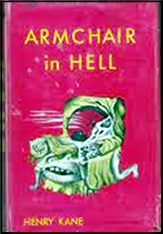
At the house Chambers and Ziggy find two additional corpses: a henchman of the gambler’s and a prominent art dealer. Chambers has his client steal a car, take the bodies and dump them near the river, then joins Ziggy for a 4:00 A.M. conference over cheesecake and coffee and learns that the gambler had been promised $500,000 to act as go-between in the transfer of some priceless tapestries that had been taken out of France by the Nazis during World War II.
Those tapestries are Kane’s version of what Hammett called the black bird and Hitchcock the McGuffin. Like any McGuffin worthy of the name, this one is being sought by an assortment of questionable characters, including a blonde sexpot, a brunette sexpot, an art critic (whom Chambers describes as “a California elfâ€), an oddball Frenchman, a pool shark, a ballroom manager, and a sinister dwarf with a huge moronic goon who, in a scene reminiscent of the beating of Ned Beaumont in Hammett’s THE GLASS KEY, marks Chambers up with a set of brass knuckles.
The climax calls to mind the conference among all the parties near the end of THE MALTESE FALCON, with Chambers pulling the strings so that the murderer is gunned down in front of witnesses by one of the other contenders for the tapestries.

Our friend the student of political incorrectness will find short rations in this one, mainly the scene where Chambers asks about another character’s sexual preference or, as he phrases it, whether the man is “a nancy…. A fruit, a milky way, a buttercup.†Any such student who stopped there would miss perhaps the most interesting moment in the book, a sort of meta-scene where Chambers describes not only himself but almost every PI who came into the genre in Chandler’s shadow.
He “has no wife, or sleep, or food, or rest. He drinks, drinks more, and more; flirts with women, blondes mostly, who talk hard but act soft, then he drinks more, then, somewhere in the middle, he gets dreadfully beaten about, then he drinks more, then he says a few dirty words, then he stumbles around, punch-drunk-like, but he is very smart and adds up a lot of two’s and two’s, and then the case gets solved….â€
Later that year Simon & Schuster published REPORT FOR A CORPSE (1948), a collection of Kane’s first six short stories, all from Esquire. Whereas in his book-length cases Chambers had been a member of a PI firm complete with senior partner, an old-maidish secretary and at least three legpersons, in these shorter tales he’s a lone wolf with only the secretary Miranda Foxworth carried over from the novels.

For some unaccountable reason the stories in book form are not printed in chronological sequence but I shall cover them in Esquire’s order.
“A Glass of Milk†(February 1947) opens on a Sunday afternoon as Chambers enters an elegant Madison Avenue drinking place, spies a beautiful blonde at the end of the bar nursing a glass of milk and orders another: obviously a prearranged signal. The blonde leaves and Chambers follows her to her apartment where she makes him a real drink, tells him she’s changed her mind about hiring him, and gives him fifty dollars for his time and trouble.
That evening he’s visited by his friendly enemy Lieutenant Parker, telling him that the woman has been found dead, with her face mashed in, and Chambers’ prints all over the hotel suite. Chambers explains about the assignation at the bar but the apartment staff insist she never went anywhere that day and the bartender says he never served any blonde a glass of milk.
Instantly we’re reminded of the situation in Cornell Woolrich’s iconic novel PHANTOM LADY (1942), with Chambers taking the part of the man who’s wrongly accused of his wife’s murder while he was in a bar with a woman no one else saw. Kane’s version of the story makes more sense than Woolrich’s but then he didn’t have to reach book length.
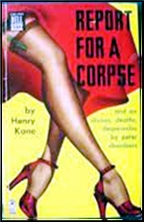
Criminal lawyer Sonny Evans, who was an offstage character in A HALO FOR NOBODY, has a scene in “A Matter of Motive†(March 1947). It’s at his recommendation that Chambers is hired when a drugstore owner is charged with the murder of one of his clerks, who was blackmailing him over his sideline as a narcotics dealer, and with whom he had an appointment around the time of the killing.
The next most likely suspect is the dead man’s nightclub-singer fiancée, who was also the beneficiary of his life insurance policy. Chambers searches the scene of the murder and finds a letter indicating that the dead man was having an affair with his blackmail victim’s wife and was about to break it off. With two female suspects, both of whom admit they were near the crime scene at the crucial time, plus of course his client, who also had motive and opportunity, Chambers figures out who done it in a manner reasonably fair to the reader.
You’d never guess from the flippant title of “Kudos for the Kid†(May 1947) that it’s quite close to a traditional detective tale, with Chambers addressing his friendly enemy as “my dear Parker†and the lieutenant in turn griping about the PI’s Sherlock Holmes act.
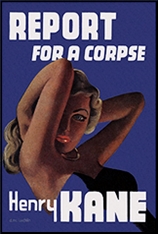
Chambers happens to stop at a Fifth Avenue candy store to ogle a beautiful blonde staring into the shop window and is immediately invited to accompany her to an apartment hotel. What sounds like an invitation to bedplay quickly turns out otherwise: the blonde had lost a valuable emerald earring at a dance and was waiting for the person who had advertised in the newspaper, asking whoever lost the earring to meet him in front of the candy store, prove ownership of the jewel and take it back.
Matters are straightened out in the hotel’s tower suite but before leaving Chambers discovers the blonde’s wealthy father dead of two bullet wounds in the stomach. Parker and the police doctor call it suicide but Chambers insists that suicides don’t shoot themselves in the stomach and instantly deduces the murderer (who appears onstage for exactly four paragraphs), then pulls a huge bluff to make the culprit confess.
In the collection’s title story, “Report for a Corpse†(July 1947), a wealthy old woman hires Chambers to find out how her unfaithful husband, whom she’s refused to divorce (at a time when the only ground for divorce under New York law was adultery), plans to kill her. Shadowing the errant husband, Chambers discovers that he’s surreptitiously collected a huge supply of barbiturates.
Visiting his client’s stately home to report to her, he gets to meet the couple’s lovely adopted daughter and apparently has a quickie with her. Soon afterwards the older woman is found dead of an overdose of, you guessed it, barbiturates. Chambers fakes an alibi for the husband and then pins the crime on — well, I’d be a toad if I said more.
With five violent deaths and a plot rooted in events of a dozen years earlier, “The Shoe Fits†(July 1947) leads one to suspect that Kane had begun it as a novel and then, changing his mind, had boiled it down to the length of his other Esquire tales. In Hollywood to act as a $750-a-week technical adviser on a PI epic — perhaps a follow-up to THE BIG SLEEP? — Chambers is offered a bonus by the producer and director of the movie to bodyguard a Nevada casino owner who’s deeply in debt to the Mob and likely to be killed for welshing.
The guy is murdered before Chambers can take on the job but our sleuth suspects that it wasn’t a Mob hit, follows the trail back to New York and three deaths that took place years before, returns to Hollywood and wraps things up as usual. One of the central clues is gibberish except to dyed-in-the-wool New Yorkers and another stands out like W.C. Fields’ nose to anyone who remembers a little high-school German.
In “Suicide Is Scandalous†(June 1948) Chambers’ client is another old lady and his job is to prove that one of her stepdaughters, an unaccountably wealthy woman who according to the evidence shot herself to death in her Park Avenue apartment on a Sunday morning, was actually a murder victim.
If in fact she was murdered, the prime suspects would be the client herself and her other stepdaughter, each of whom inherits half under the dead woman’s will. With the bullet in her head clearly fired from her own gun and with a suicide note in her own handwriting found beside her body, Chambers seems to be up against a stone wall.
But with the help of a penmanship clue borrowed from A HALO FOR NOBODY, and after a fistfight with the murderer, he breaks down the wall and earns his fee.
Kane’s Esquire appearances were not limited to short stories. The magazine had published a condensed version of ARMCHAIR IN HELL (January 1948) and also ran condensations of his third, fourth and fifth novels, which I’ll discuss in another column, plus a single stand-alone short story, never collected (“Lost Epilogue,†October 1948).
During the 1950s Kane’s novels were all paperback originals, his short stories appeared usually in Manhunt, and he perfected the oddball narrative style known to his admirers as High Kanese. Perhaps I’ll explore these later too.
December 2nd, 2021 at 10:28 pm
I like the mid era High Kanese style better, but find Kane no more offensive than most eyes of the era. His best work is slick, slender, and painless bordering on the screwball school.
His later Inspector McGreggor books got some decent critical attention.
Kane and Chambers have one achievement, both recovered from having descended into soft porn and made something of a comeback. I can’t think of another character to have done that.
Chambers and Kane were popular enough for a radio series episodes of which can still be found on various sites.
December 2nd, 2021 at 11:14 pm
What I liked about the Peter Chambers books was that not only was he a hard-boiled PI par excellence, he actually did some detective work. One of his cases, and I’m sure I remember this correctly, was a Locked Room affair.
But don’t think his books for Lancer were soft porn. They were as X-rated as you can get. Unforgivable, for an author of Kane’s ability.
The radio show was pretty much Kane’s total creation. He both produced it and wrote the stories. The title was CRIME AND PETER CHAMBERS, and starred Dane Clark. It was on NBC for about six months over the summer of 1954.
It wasn’t bad, but the radio networks were fighting a losing battle with TV at at the time.
December 3rd, 2021 at 5:56 am
“Those tapestries are Kane’s version of what Hammett called the black bird and Hitchcock the McGuffin.”
Antique tapestries are bulky, heavy and fragile. They aren’t like a gold falcon and have to be very carefully stored, packed and moved or they stop being valuable. Does Kane make allowances for problems like that?
December 3rd, 2021 at 9:32 am
The only Kane novel read here is the locked room book Steve mentions, “Too French and Too Deadly”. Thought it was Too Styleless and Too Dull.
Bet the Minister of Culture in Paris would say that you can NEVER be Too French. Are Renoir and Paul Halter Too French? Mais non!
Esquire has been going for nearly 100 years. But I’ve never figured out what it is contributing to American Culture. It published the late fiction of F. Scott Fitzgerald. This is good and collected in Fitzgerald books. And it gave a start in the 60’s to the filmmaking team of Robert Benton and David Newman. Beyond this I know nothing.
December 3rd, 2021 at 12:55 pm
I’ll have to read TOO FRENCH AND TOO DEADLY again. At the time, I thought it was pretty good.
But I was much younger then.
December 3rd, 2021 at 9:58 pm
ESQUIRE among others published THE SNOWS OF KILAMANJARO, the pin up art of Vargas, and some of the finest American writers of the generation preceding mine and following it.
Whether you like the magazine or not it was one of the few to still honor fiction long after no other major magazines save for PLAYBOY published any.
Gore Vidal, Fitzgerald, Hemingway, Salter, Mailer, James Jones… it’s a pretty good line-up along with some popular writers in the earlier years of the magazine.
Granted it was always a men’s magazine and it’s early years with mascot Esqy were sexist, but no more than anything else published at the time.
Growing up in a smalltown ESQUIRE and THE NEW YORKER were about as sophisticated as a teenage boy was going to get at a local newsstand, a step up from PLAYBOY and certainly more literate than most magazines available to a sixteen year old in North Texas.
December 3rd, 2021 at 10:30 pm
There were always a lot of insecure, anti-intellectual in-jokes about Esquire in 50s and 60s pop culture. You can always come across them when browsing about. I’m sure such references are lost on most people today.
Me, I always confused ‘Esquire’ with ‘Escapade’… a less-savory competitor.
February 24th, 2022 at 1:09 am
[…] It’s only my opinion – I have no stats to back this up – but as an author of any number of crime novels, and in particular, the creator of New York City-based PI Peter Chamber, Henry Kane has largely been forgotten in recent years. One exception is, of course, Mike Nevins’ covered his early years in one of the monthly columns he does for this blog. One of the stories covered, in fact, is this very one. Go here. […]